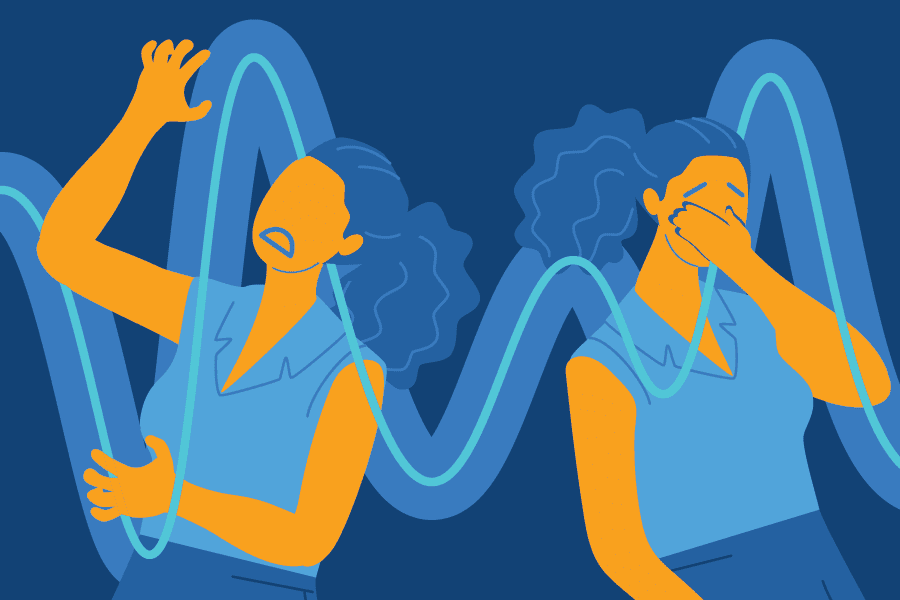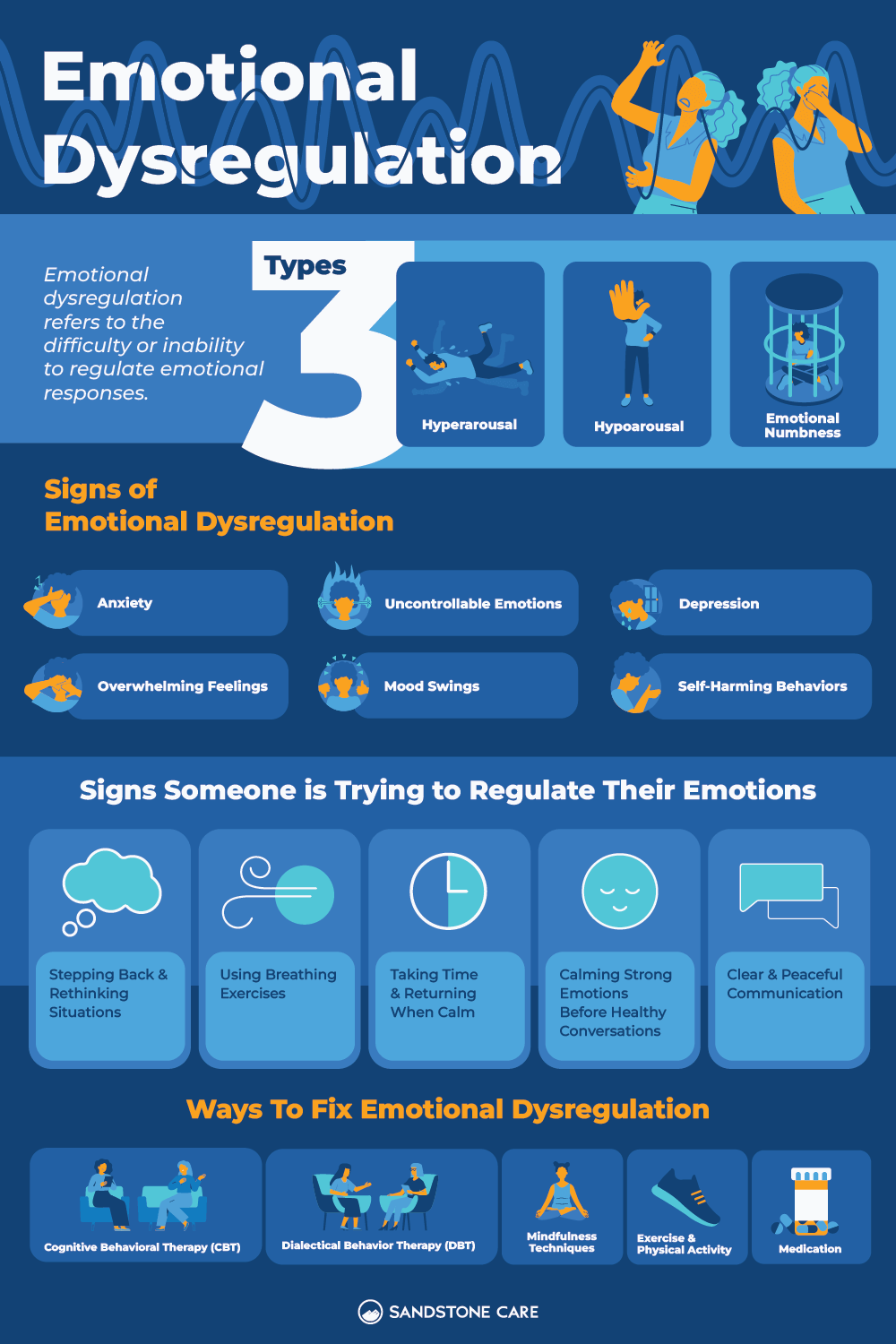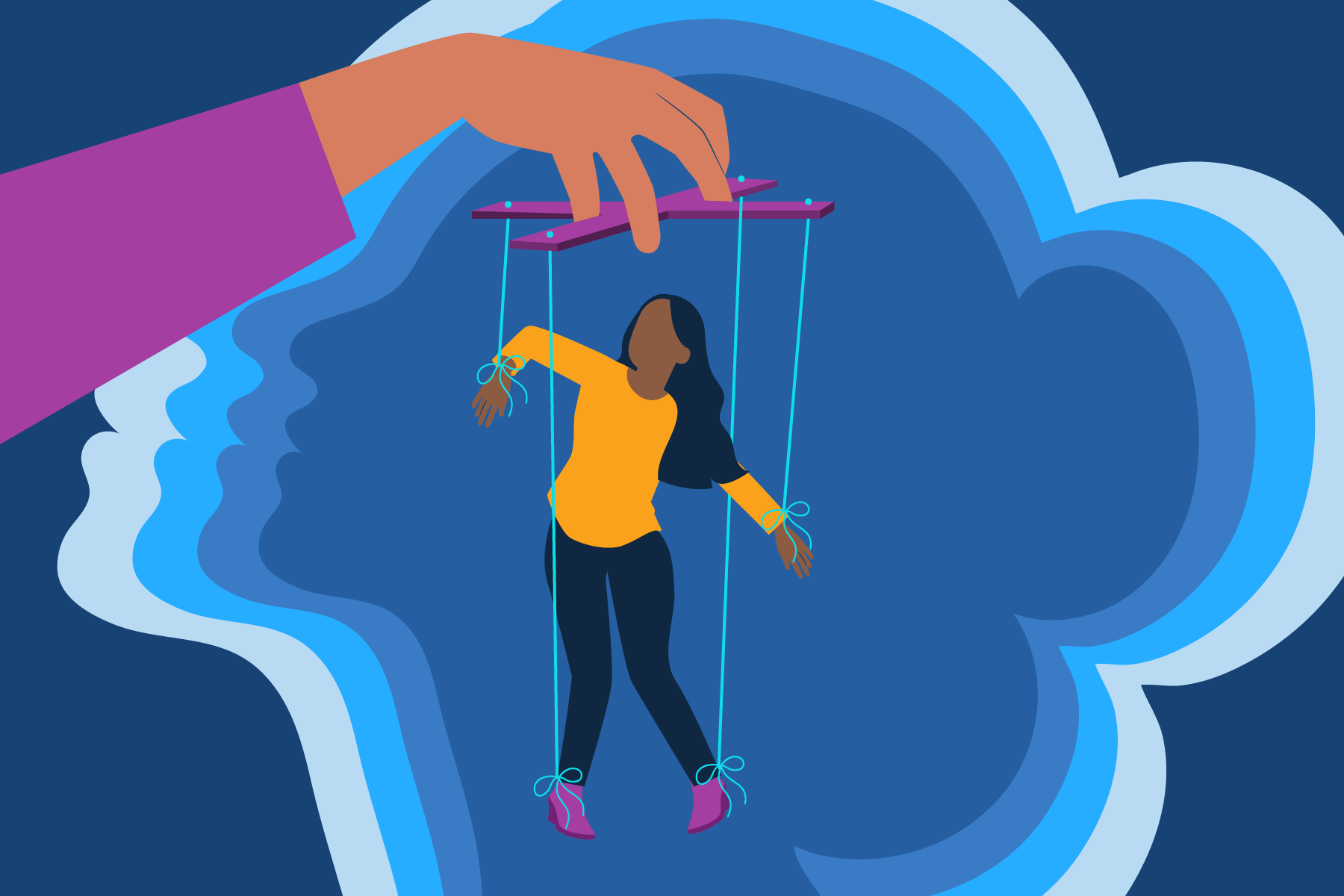Emotional Dysregulation ADHD
What Is Emotional Dysregulation?
Emotional dysregulation refers to the difficulty or inability to regulate emotional responses.
People with emotional dysregulation may experience strong emotional reactions, overwhelming negative emotions, difficulty controlling their emotions, and difficulty coping with stress.
What Are the Three Types of Emotion Regulation?
Emotion regulation can fall under three general types, including:
- Attentional Control
This type of emotional regulation helps individuals concentrate.
- Cognitive Reappraisal
This type of regulation is centered on how people think or “frame” what they experience.
- Response Modulation
This form of emotional regulation impacts how strongly a person reacts to any given event and what that response looks like.
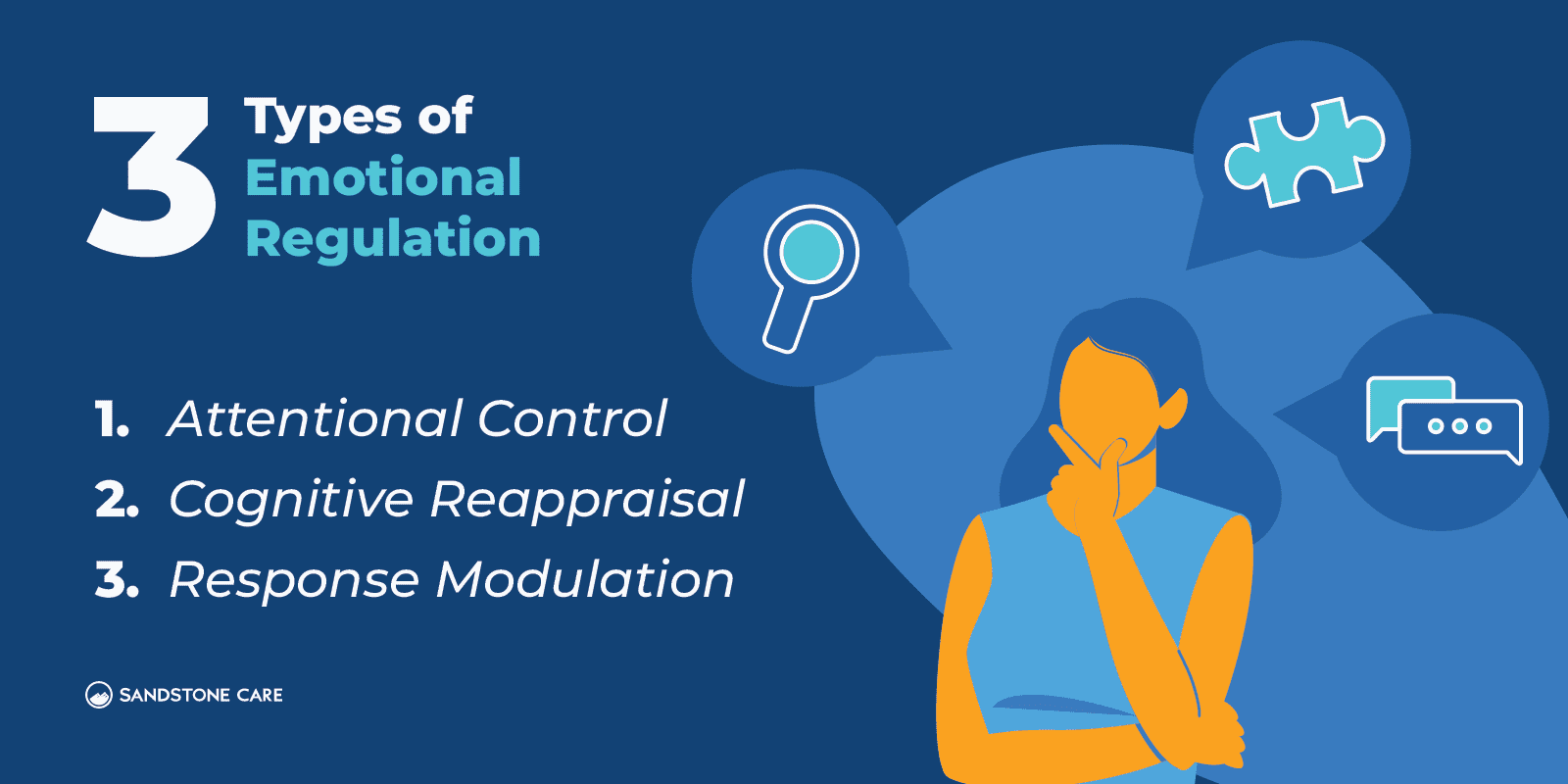
Why Is Emotional Dysregulation a Problem?
When a person experiences emotional dysregulation, it can be tough to manage their feelings, leading to emotional outbursts, anxiety, depression, substance abuse, self-harm, suicidal thoughts, and many other harmful behaviors.
If you or a loved one are experiencing suicidal thoughts, seek help and know you are not alone. You can call the National Suicide Prevention Lifeline at 988 or call 911.
Do People With ADHD Struggle With Emotional Regulation?
ADHD and emotional regulation can sometimes clash. A person with attention-deficit hyperactivity disorder (ADHD) may experience intense emotions that can be hard to manage and regulate.
It can also be hard to express these emotions and take their focus off of strong emotions.
Emotional dysregulation for individuals with ADHD can make it hard to find emotional balance, to mentally move on from conflict, or to get out of a negative loop of thoughts. These negative loops can sometimes lead to overthinking or rumination.

Do you have ADHD? Find out Now
What Is the Power of Emotional Regulation?
Emotional regulation can help a person’s health, well-being, work success, school life, and the healthiness of their relationships.
When a person has emotional control, they can find more calmness and happiness, even in times of stress.
For example, when they experience difficult transitions or loss, they are able to process grief with patience and healthy coping skills.
With a balanced emotional state, it is easier to build healthy relationships with others and with themselves.
Types of Emotional Dysregulation
What Are the Three Types of Emotion Dysregulation?
A. Hyperarousal
Intense thoughts, feelings, and reactions compared to those of the average person are experienced by individuals with hyperarousal. This could appear as angry outbursts or frequent meltdowns.
B. Hypoarousal
When hypoarousal occurs, a person’s emotional tolerance is too little or too low, which can involve emotional numbing, social withdrawal, and a disconnect between the body and feelings. This could appear as self-isolation.
C. Emotional Numbness
When people are emotionally numb, they feel empty, disconnected from themselves and others, and isolated.
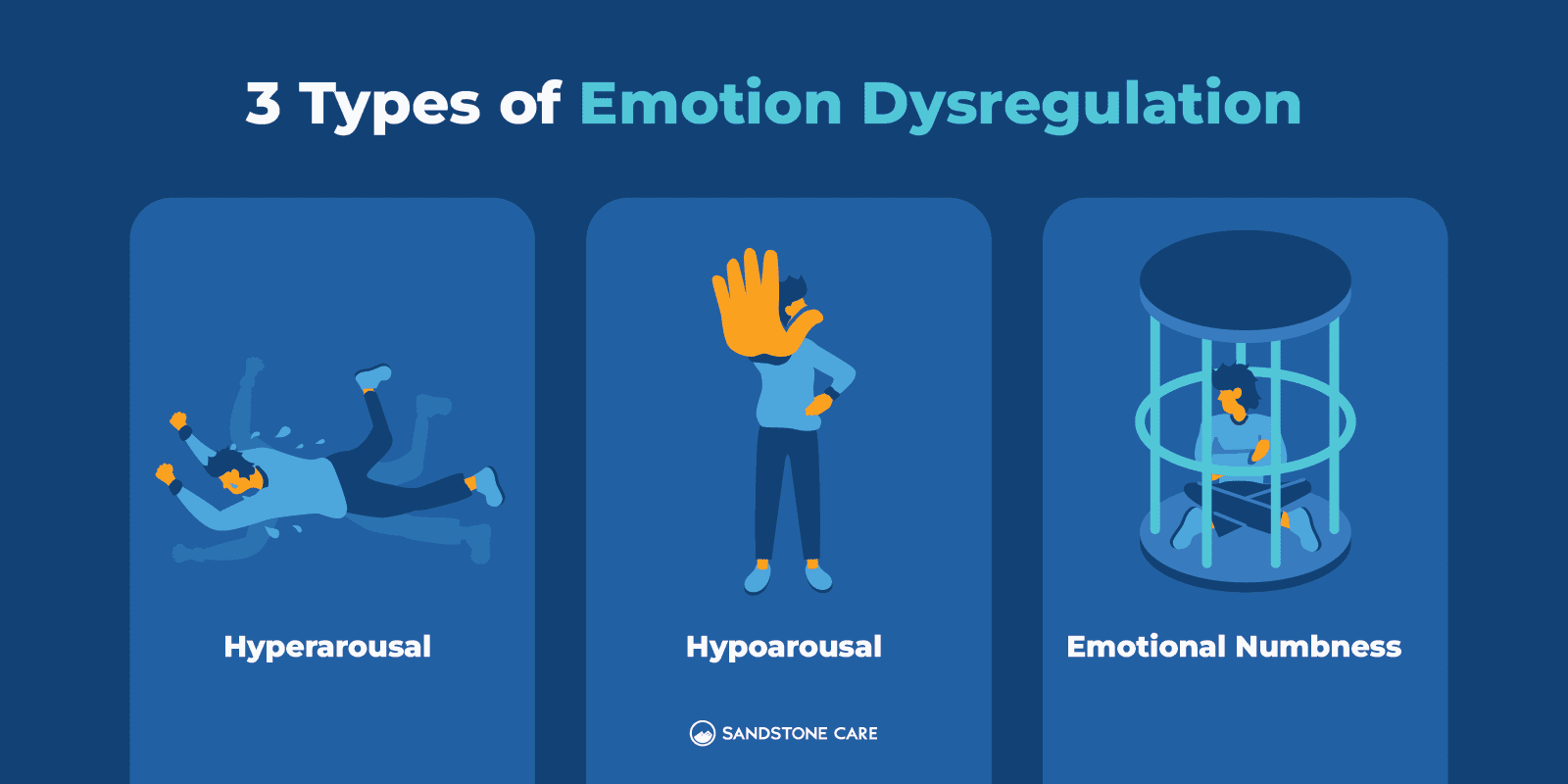
What Are Examples of Emotional Dysregulation?
Common examples of emotional dysregulation can include:
- Having difficulty calming down, even if the person knows the situation is not significant
- Feeling strong emotions for no reason
- Low tolerance for frustration
- Sudden or frequent outbursts
- Feeling overwhelmed by emotions
- Having a hard time focusing on anything else but emotions or an emotional situation
Emotional Dysregulation Causes
What Causes Emotional Dysregulation?
Emotional dysregulation can be caused by several different things, such as:
- Early childhood trauma
Stressful or life-altering events in early childhood can cause sensitization to the central nervous system and disrupt emotional regulation, even throughout adulthood.
Examples of childhood trauma can include abuse, neglect, or domestic violence from a caregiver, friend, or close relative. - Genetic factors
According to the World Journal of Psychiatry, certain alleles of the 5-HTTLPR gene polymorphism have been associated with traits linked to emotion dysregulation. - Environmental factors
An individual’s environment can play a significant role in their mental health. Whether it is the family environment or the physical environment they are in, it can impact a person’s ability to process and respond to emotions. - Traumatic brain injury
A person with a traumatic brain injury can experience changes in their thinking abilities. This can affect the way they process and respond to emotions. - Mental health disorders
Comorbidities or other mental health disorders like anxiety, ADHD, or bipolar disorder can impact how the brain works and lead to emotion dysregulation.
Why Can’t I Control My Emotions?
Figuring out why you personally struggle to control your emotions starts with paying close attention to patterns in your behavior and feelings.
One way to do this is by keeping track of moments when your emotions feel overwhelming.
Writing down when and where these moments happen, what you were doing, and how you felt can help you notice triggers or specific situations that seem to set off strong reactions. These triggers could be certain people, places, or types of stress.
Another approach is to tune into your physical reactions during emotional moments.
Do you notice your heart racing, palms sweating, or feeling tense? These physical signs can give you clues about when you’re feeling stressed or anxious, even before you recognize the emotion itself.
It’s also helpful to reflect on your past experiences. If you’ve gone through tough situations like trauma, loss, or high levels of stress, these experiences may be influencing how you handle emotions now.
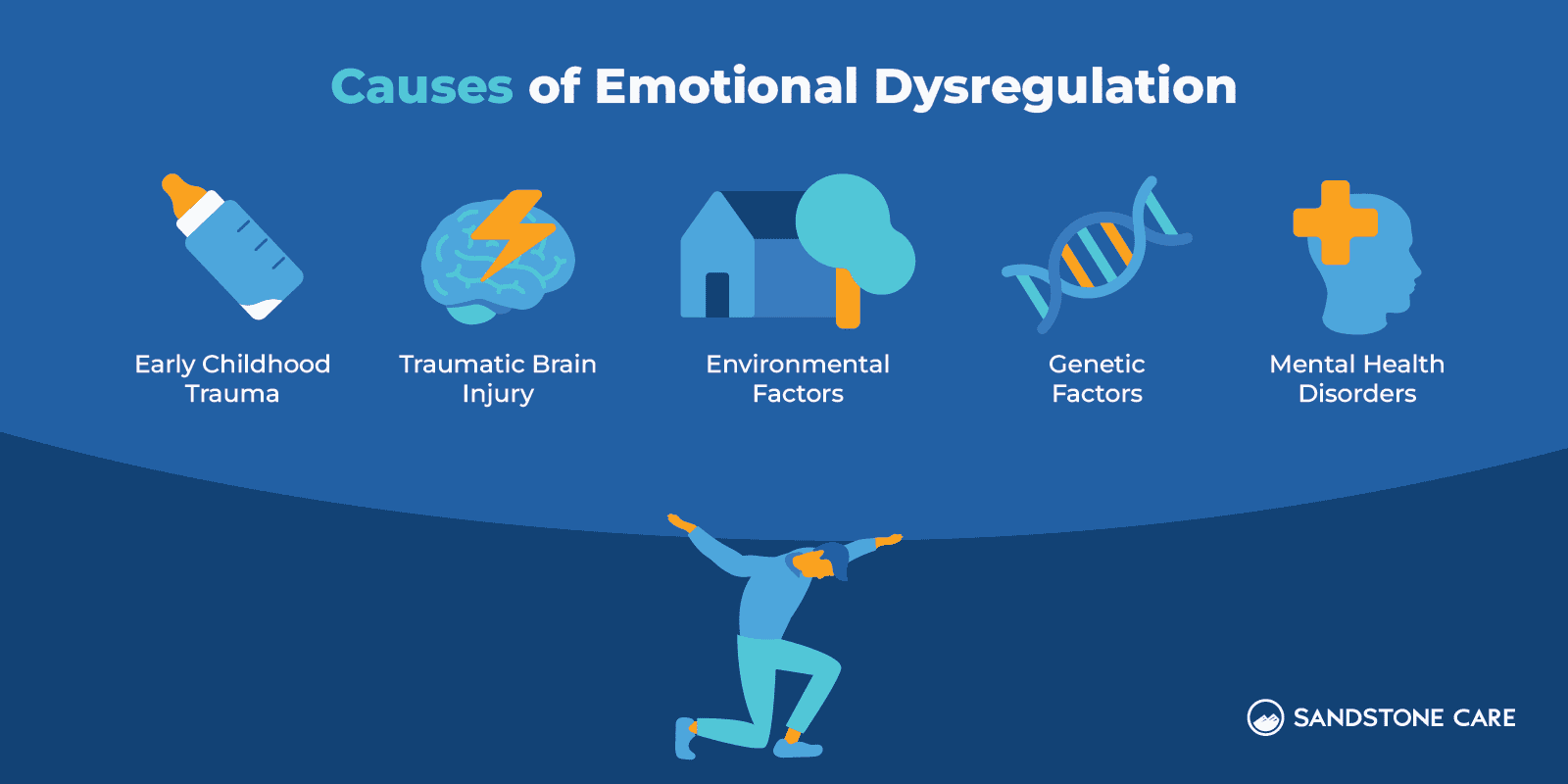
What Disorders Are Associated With Emotional Dysregulation?
Emotional dysregulation can be caused by psychiatric disorders, including:
- Anxiety disorders
- ADHD
- Autism spectrum disorder
- Bipolar disorder
- Borderline personality disorder
- Post-traumatic stress disorder
- Fetal alcohol spectrum disorders
- Disruptive mood dysregulation disorder
What Trauma Causes Emotional Dysregulation?
Individuals with complex trauma or post-traumatic stress disorder (PTSD) often display emotional dysregulation that involves fear, anxiety, sadness, or anger.
Trauma can leave a person in the “fight, flight, or freeze” mode. When a person is faced with an event perceived as threatening or harmful, the brain and body react by triggering physical and emotional responses to fighting, flying, or freezing.
For example, in a dangerous encounter with a wild animal, a person may have a surge of adrenaline in order to address the threat.
When someone experiences trauma, such as emotional abuse from a parent, they may experience higher heart rates and angry outbursts later in life when their mind feels threatened.
It is important to recognize that these evolutionary responses are the mind’s attempt at protecting us from danger, and should not be feared.
However, it is crucial to learn emotional regulation skills in order to teach the body when those responses are necessary, and when they are harmful.
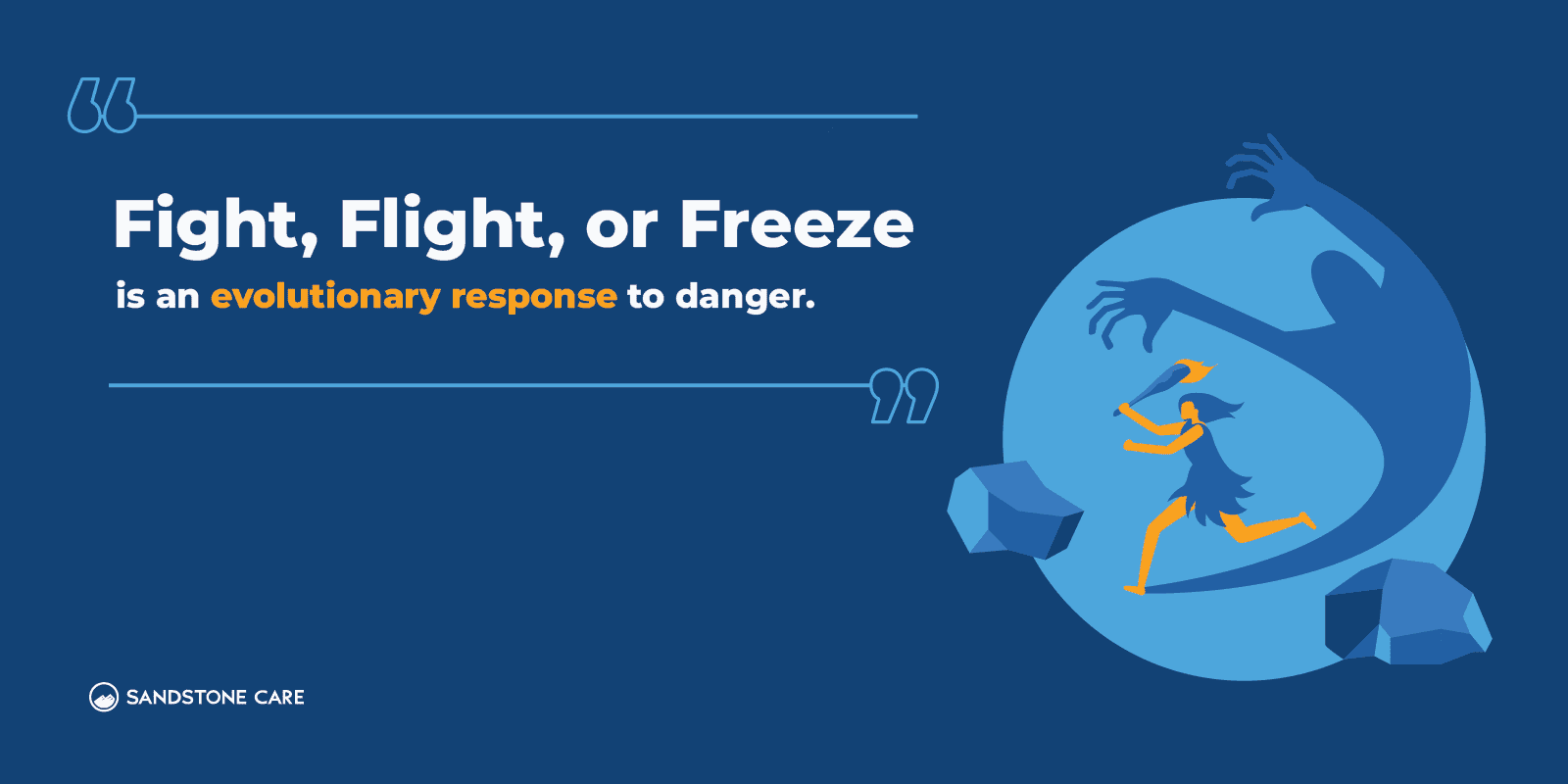
What Is at the Root of Emotional Dysregulation?
The root of emotional dysregulation can be different for every person, but it may include things like traumatic experiences or mental health conditions.
Others may be under extreme stress or impacted by genetic factors or a traumatic brain injury.
What Triggers Emotional Dysregulation?
Everyone can have different triggers for emotional dysregulation.
Emotional dysregulation can commonly be triggered by people in close relationships with the person, such as a parent, family member, or ex-romantic partner.
Others may be triggered by overwhelming environments, stressful situations, or reminders of the trauma, whether it be a person, place, or thing.
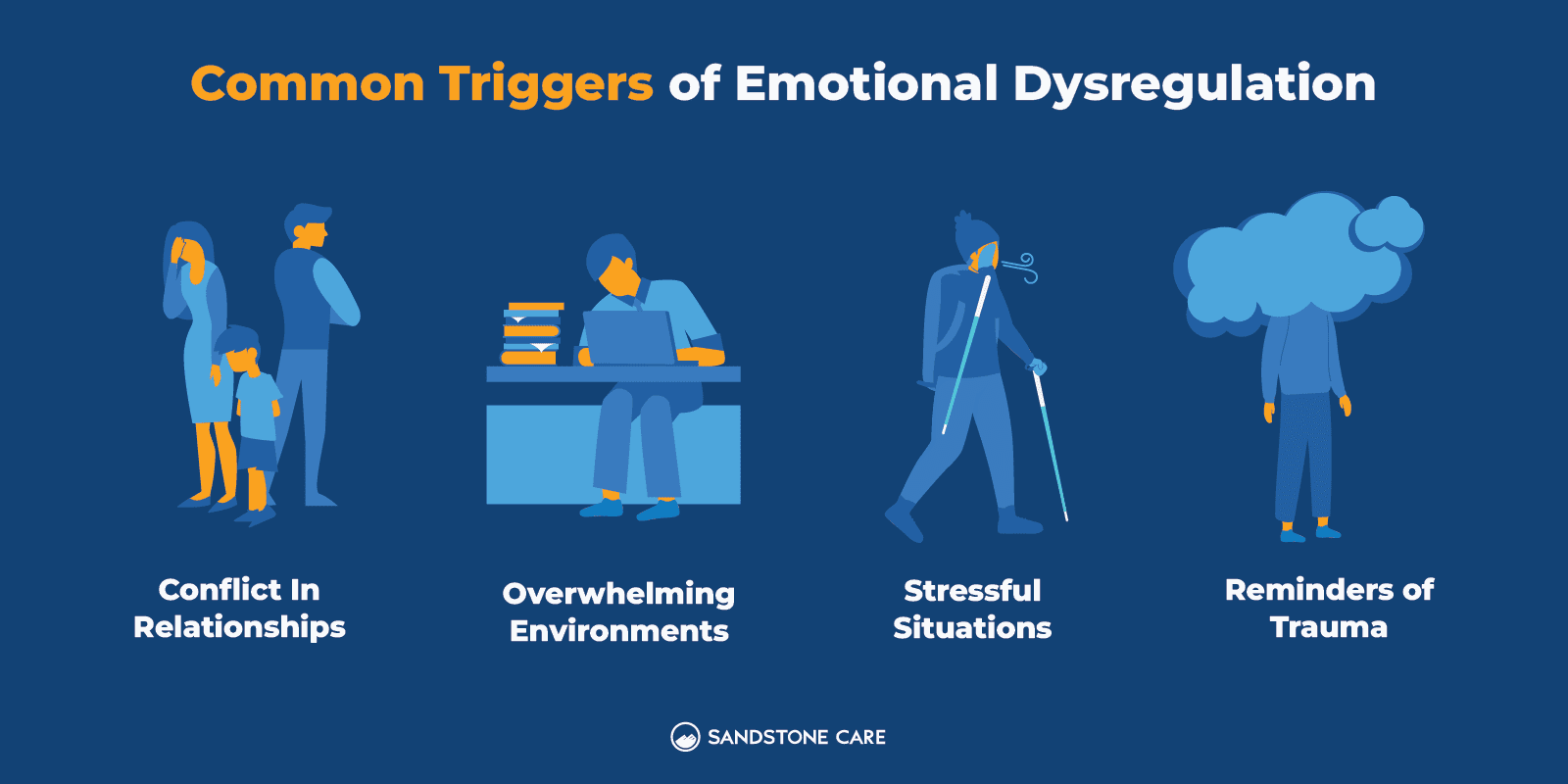
Emotional Dysregulation Symptoms
How Do You Know if You’re Emotionally Dysregulated?
Symptoms of emotional dysregulation can include:
- Intense emotions that feel very difficult to control
- Mood swings
- Feeling overwhelmed by emotions
- Random excitement bursts
- Anxiety
- Depression
- Self-harming behaviors
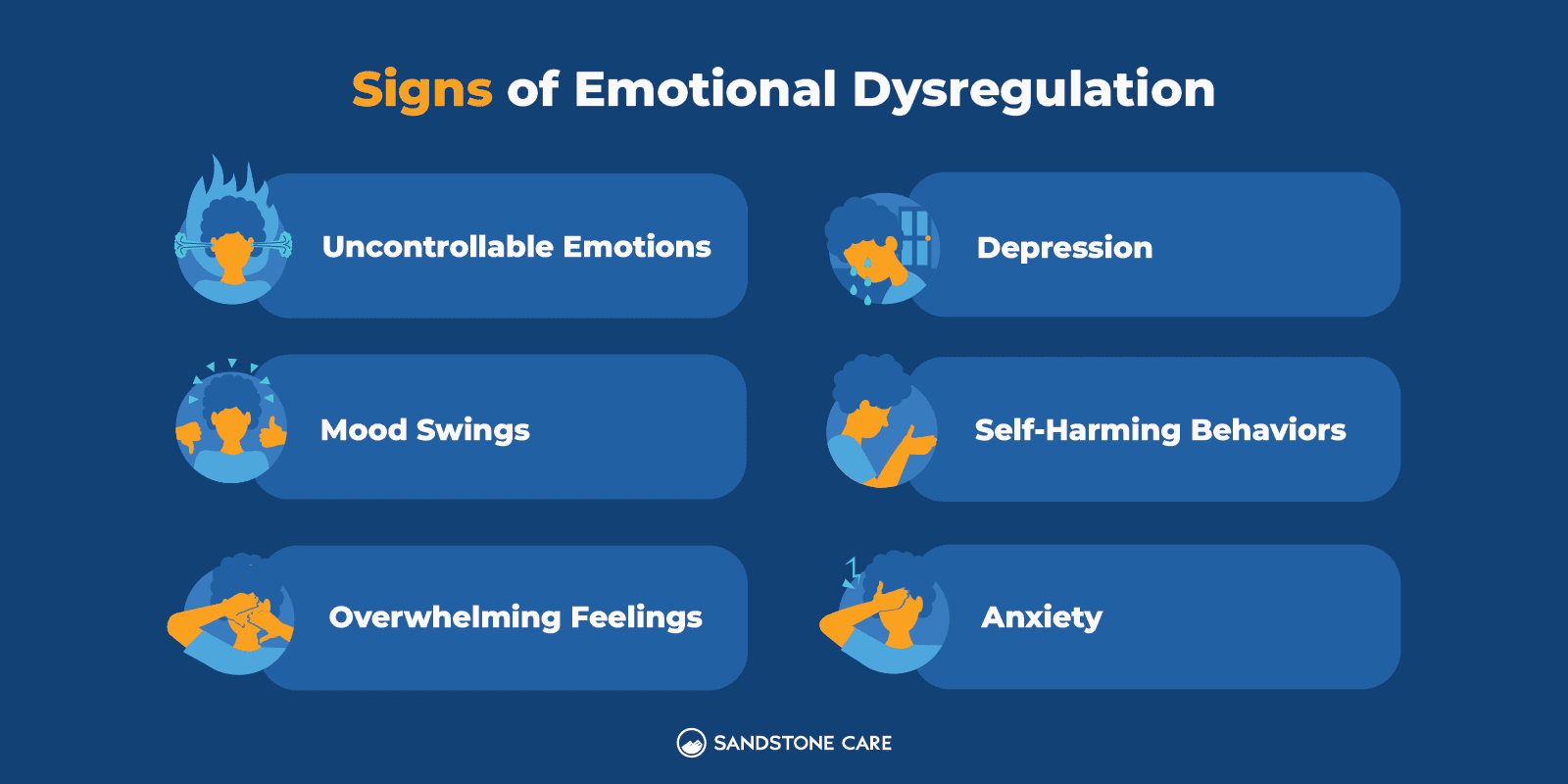
How Can You Tell if Someone Has Emotional Dysregulation?
When a person has emotional dysregulation, it can be hard to control their emotions. If faced with an emotional situation, it may cause them to spiral into a negative thought cycle.
This can cause them to have meltdowns and outbursts and seem easily angered or irritated.
Another sign a person may have emotional dysregulation is impulsivity.
Impulsivity is when a person acts without considering the consequences when they are experiencing high emotions.
They may abruptly express anger or frustration rather than processing their emotions and giving themselves time to calm down.
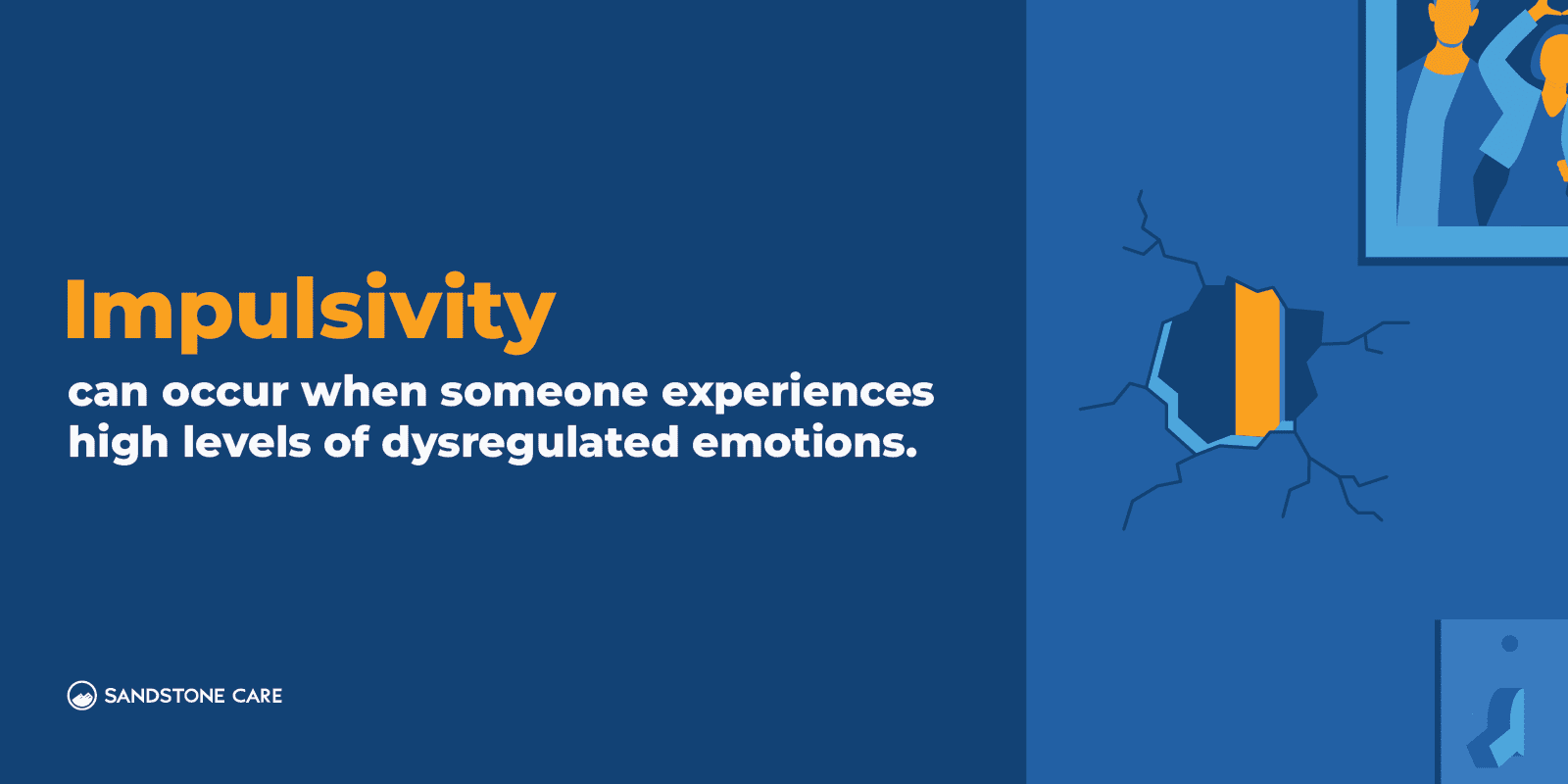
Mood swings are another common sign of emotional dysregulation. A person may feel overwhelmed by emotions, and they may feel each of these emotions very intensely within a short amount of time.
One second, they may seem completely fine, and another they may display intense emotions.
Outbursts of anger can happen when a person with emotional dysregulation feels overwhelmed and has difficulty controlling their emotions. Anger outbursts can become destructive and can lead to problems both personally and in a person’s relationships.
Lastly, a sign of emotional dysregulation can be isolation and withdrawal.
Someone with emotional dysregulation may withdraw and isolate themselves from others, even their loved ones, sometimes to try to avoid emotions or because they feel drained by others.
What Does Emotional Dysregulation Look Like in Adults?
Emotional dysregulation can look very different from person to person, but in adults it may show as being irritable or yelling a lot.
Others may become closed off, seem emotionally numb, or completely isolate themselves because it may be difficult for them to be around people.
What Are the First Signs of Emotional Regulation?
Signs a person is starting to regulate their emotions, or having affective regulation, could include:
- Taking the time to step back and rethink a situation
- Practicing calming or breathing exercises
- Taking needed space and coming back in a calm manner
- Being able to calm their emotions and have a healthy conversation after
- Having clear and calm communication
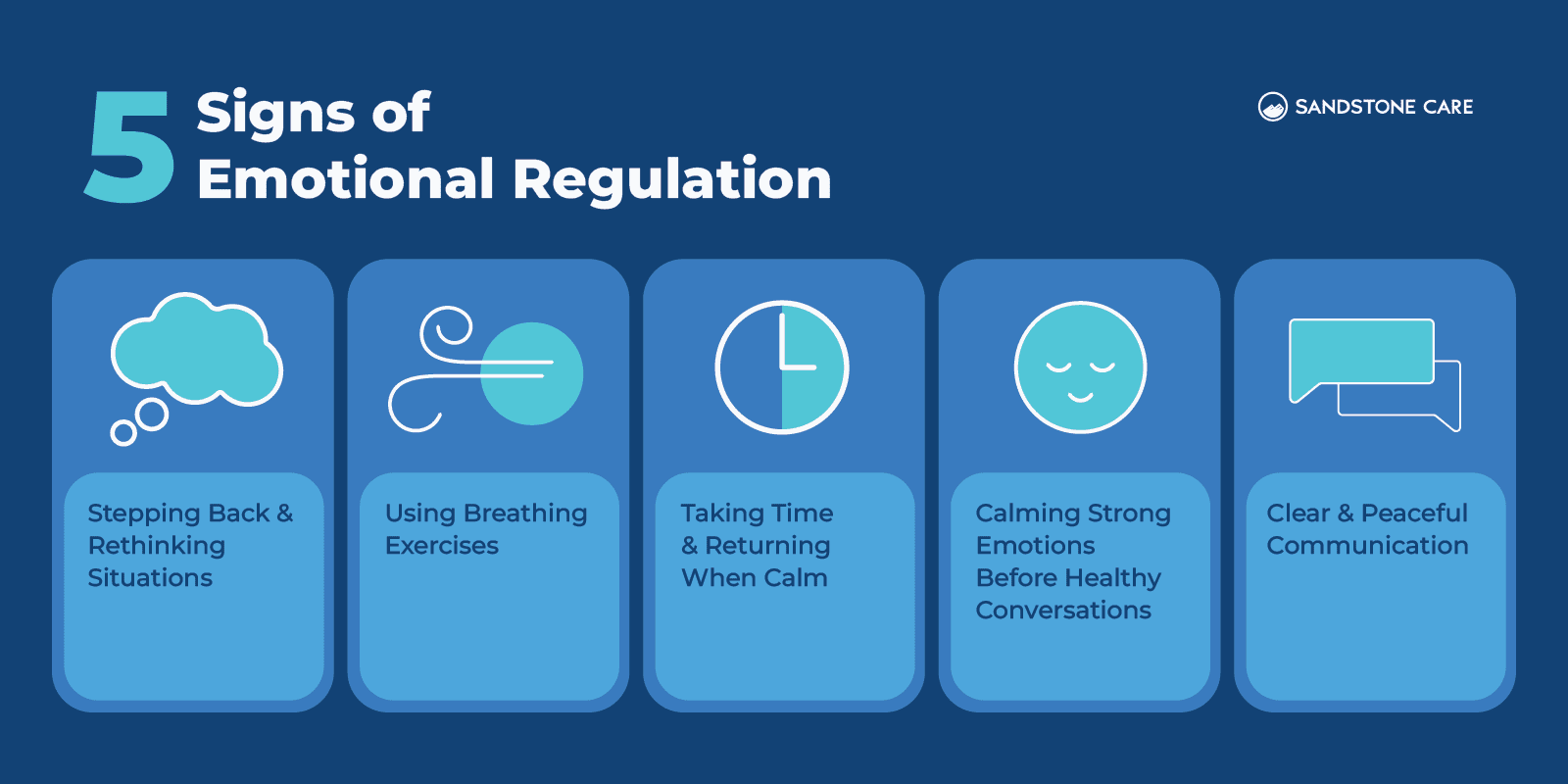
What Does an ADHD Meltdown Look Like?
ADHD meltdowns can happen when emotions build up and cause a person to feel overwhelmed.
Meltdowns with ADHD can take different forms. Some people may cry uncontrollably, others may become angry and yell, and others may feel numb or unable to move or do anything.
Side Effects of Emotional Dysregulation
What Are the Long-Term Effects of Emotional Dysregulation?
Emotional dysregulation can lead to many challenges in all aspects of a person’s life. It can make it hard to perform at work or school, maintain relationships, and harm how a person sees themselves and the world around them.
Additionally, emotional dysregulation can lead to long-term effects, including:
- Anxiety and depression
- Self-harming behaviors
- Eating Disorders
- Suicidal ideation
- Unhealthy behaviors, such as substance abuse
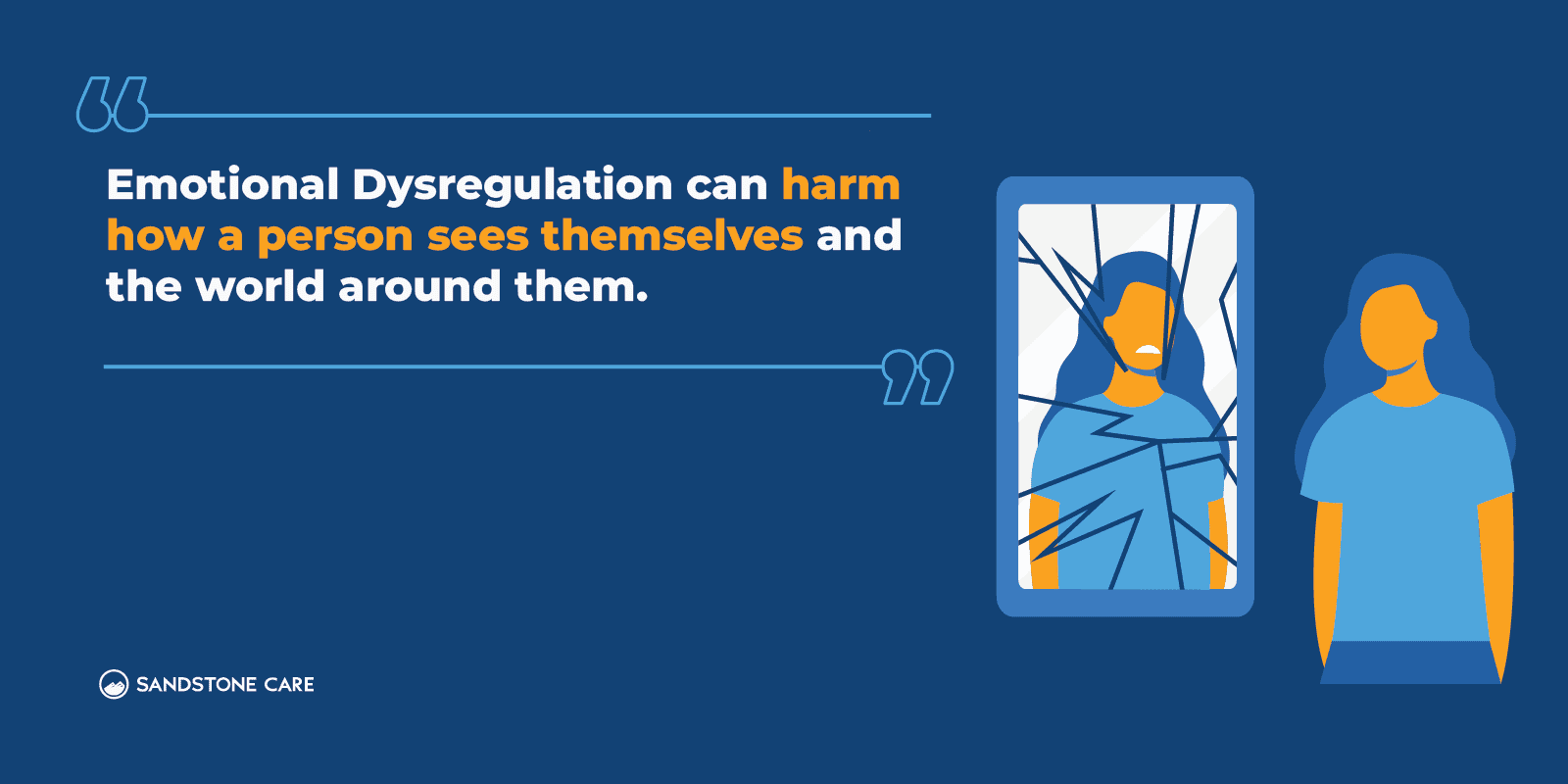
What Happens to the Brain in Emotional Dysregulation?
The limbic regions of the brain, including the amygdala and insula, have been linked to emotional reactivity, while the prefrontal regions of the brain are found to be responsible for emotional awareness, experience, and regulation, according to Social Cognitive and Affective Neuroscience.
Disruption in the prefrontal cortex can play a role in emotional dysregulation. This is part of why traumatic brain injuries are considered a risk factor for emotional dysregulation.
How Do You Live With Someone With Emotional Dysregulation?
Some ways to cope and live with someone with emotional dysregulation can include:
- Listen to them when they need to talk to someone and provide validation when needed
- Set boundaries when communicating with them
- Remind yourself that the other person may be having a difficult time, and try to be patient
- Practice self-care and make sure you have time for yourself
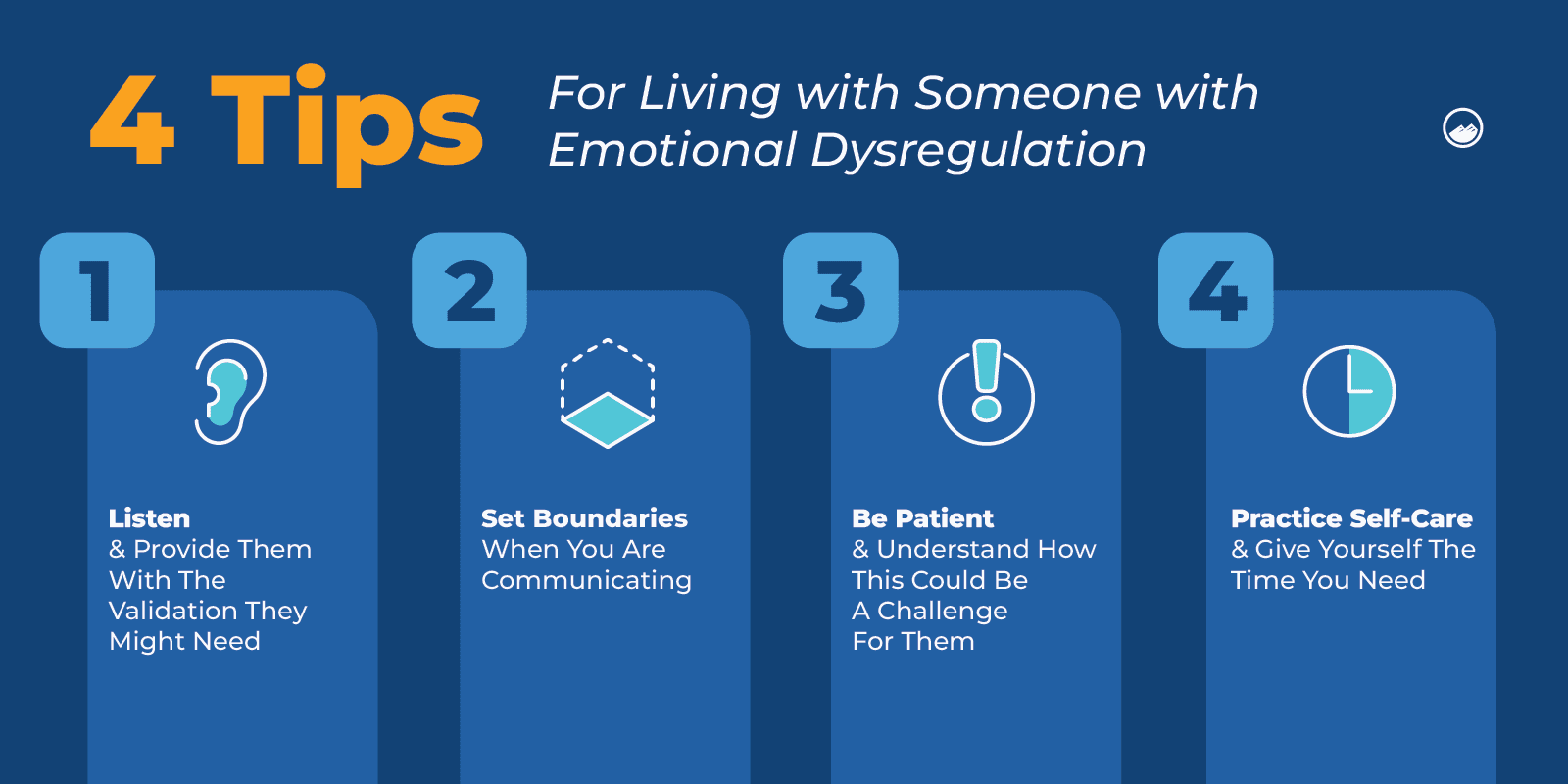
Emotional Dysregulation in Children
What Does Emotional Dysregulation Look Like in Children?
Emotional dysregulation is often seen in children through frequent tantrums and outbursts.
While some of these outbursts are normal for their stage of life, if they persist or become consistently violent, then it is time to speak with a professional to see if they are struggling with an underlying issue.
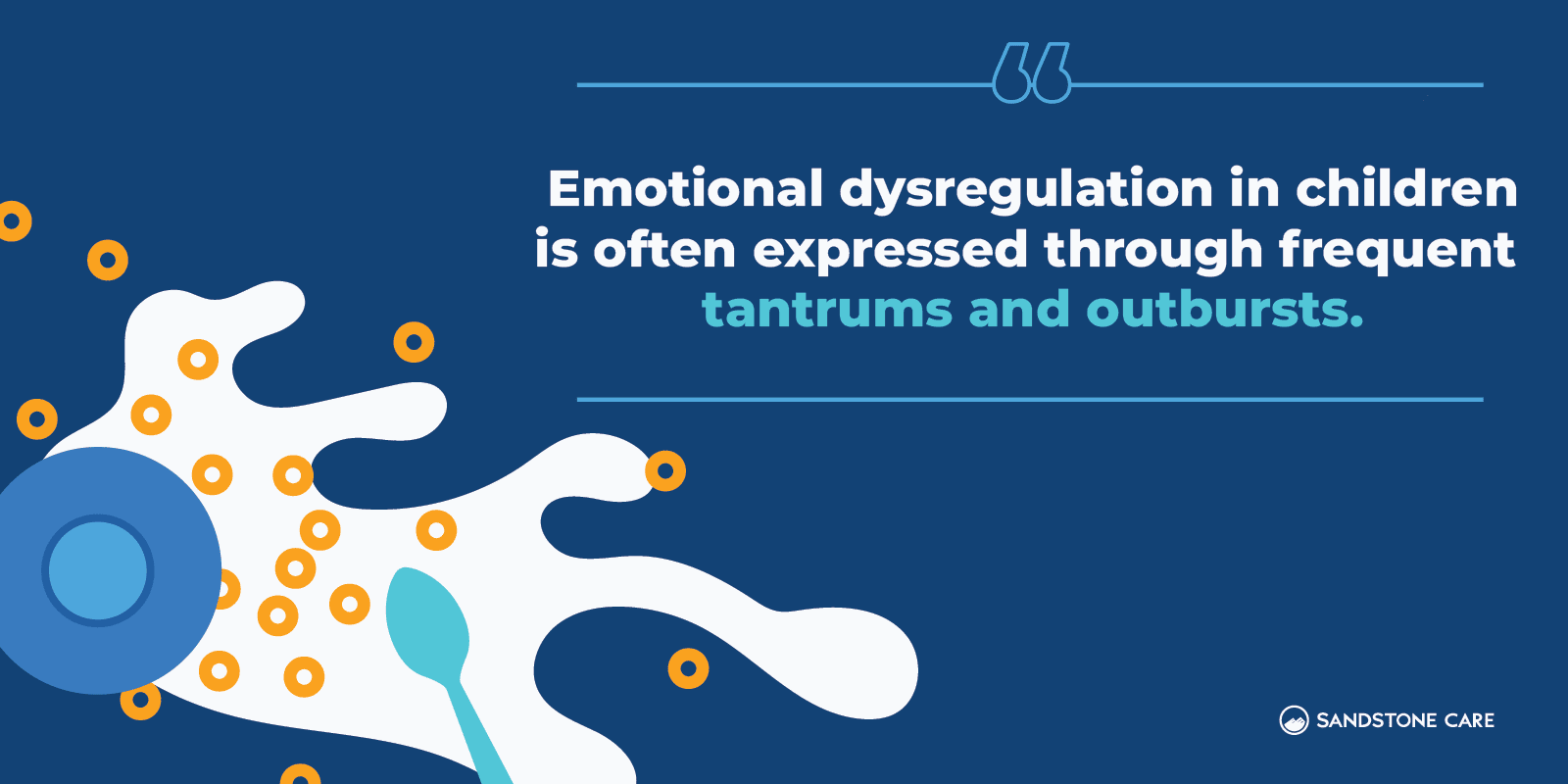
Is Emotional Dysregulation Typical in Childhood?
It is normal for children, like 2-year-olds, to have temper tantrums because they are still learning how to process and communicate their emotions.
But, as children get older, they should learn how to regulate their emotions and experience fewer tantrums and outbursts as time passes.
Emotional dysregulation can be present in children with developmental delays such as ADHD or autism or children with mood and anxiety disorders.
Clinicians and primary care providers can help to chart the stages of development and asses the child for any possible disorders.
What Causes Emotional Dysregulation in Kids?
Emotional dysregulation in kids can be caused by a number of different factors, including:
- Trauma
- Stressful life events
- Mental health disorders
How Can I Help My Child With Emotional Dysregulation?
Some ways to help a child with emotional dysregulation can include:
- Talking to them about emotions
- Helping them work through their emotions by learning to identify them and teaching them healthy coping strategies
- Validating their feelings
- Show acceptance
- Avoid reinforcing tantrums or outbursts
What Are the Three R’s in Helping a Child Who Is Emotionally Dysregulated to Regulate?
The three R’s in helping a child who is emotionally dysregulated are to regulate, relate, and reason.
Regulating means that you first help your child feel safe and calm.
Relating is when you validate their feelings and make sure they feel heard and understood. Speaking clearly, in short sentences, or in a way that they will understand can help you connect and let them know they are okay.
Lastly, reasoning involves talking to your child about rules, limits, or boundaries that you have set in a way that they can learn from and understand. Reassure them that you are there for them, but make sure they know what is not okay and what is.
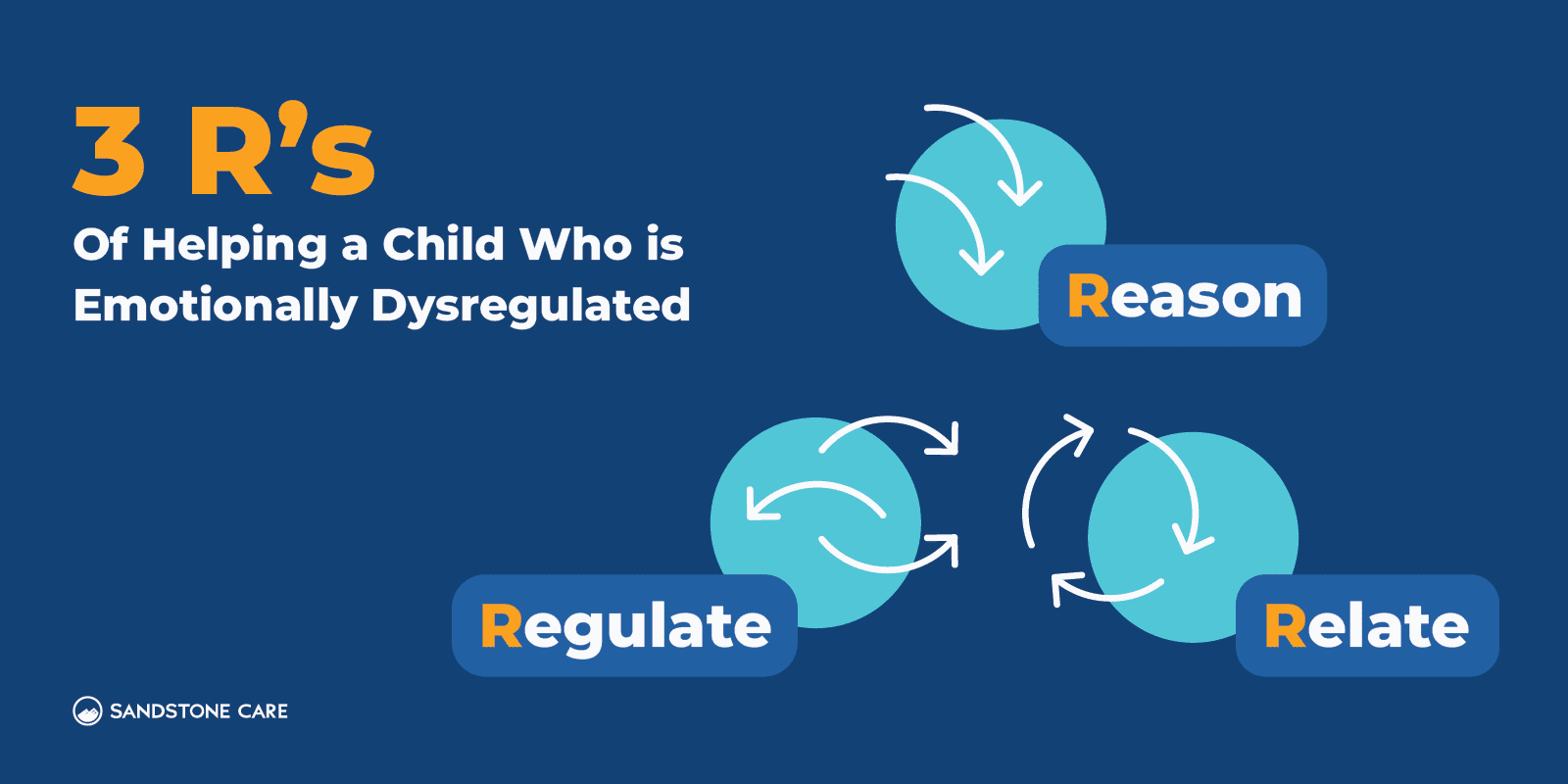
What Medication Is Used for Emotional Dysregulation in Children?
Aside from psychotherapies, some medications are used to treat emotional dysregulation in children.
Antidepressants, such as selective serotonin reuptake inhibitors (SSRIs), may sometimes be used for children with disruptive mood dysregulation disorder. SSRIs can work to stabilize the serotonin levels in the brain, providing a baseline that helps the body to regulate its neurochemistry.
However, it is important to talk with your child’s healthcare provider about what medications are the most safe and effective interventions for your child.
Emotional Dysregulation Treatment & Coping
Does Emotional Dysregulation Go Away?
When a person experiences emotional dysregulation, especially as a young child, it can carry over into adulthood.
For some people, it may go away over time as they get older, but for others, it could indicate an underlying mental health condition.
In this case, it is important to find out the root cause of emotional dysregulation and get the proper treatment that works best for each individual.
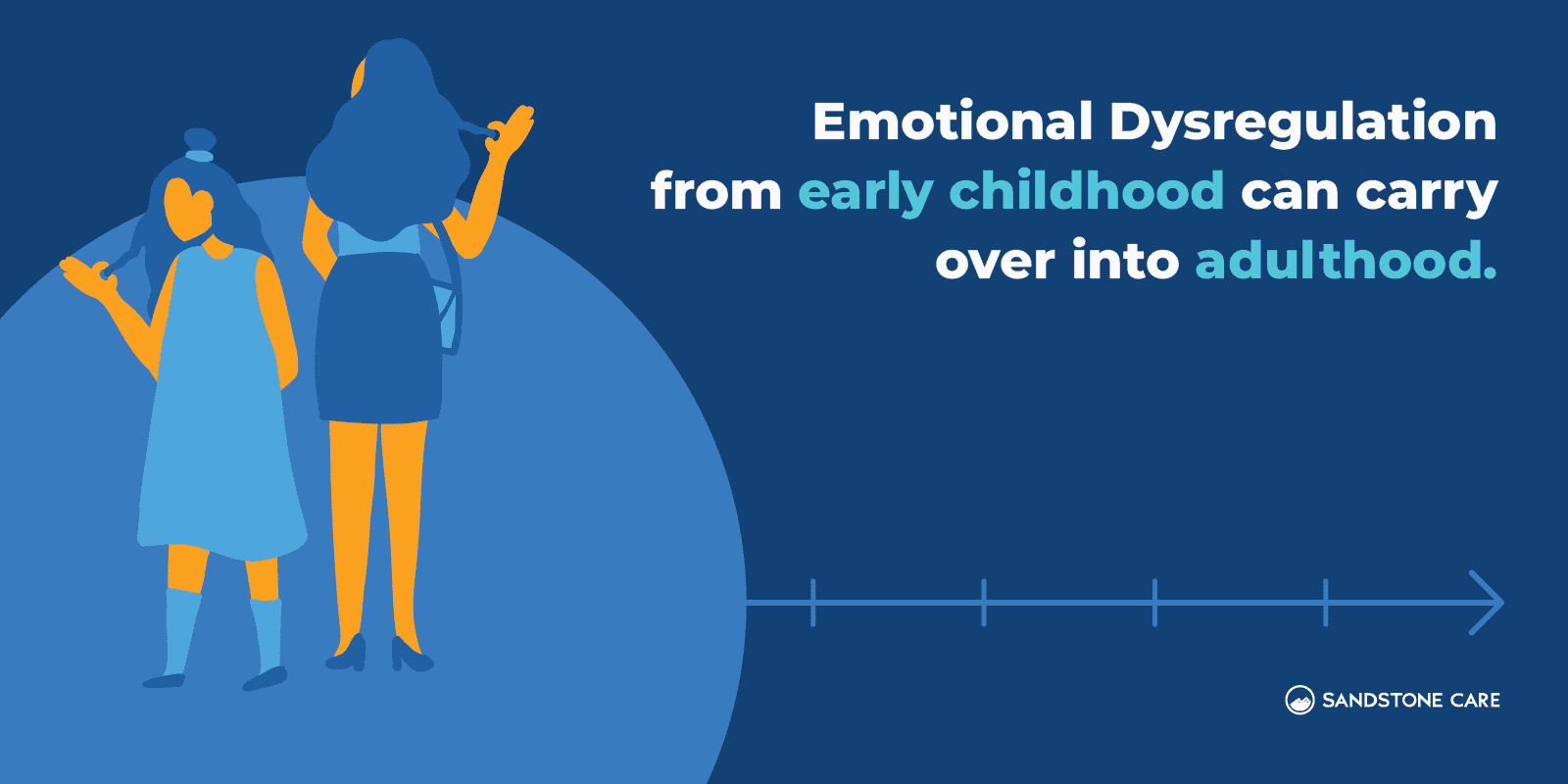
How Do You Fix Emotional Dysregulation?
There are a number of different psychotherapies and other approaches that can help a person with emotional dysregulation.
These can include:
- Dialectical Behavioral Therapy (DBT)
DBT focuses on the balance of acceptance and change with a person’s thoughts, feelings, and behaviors. It can be beneficial for individuals with borderline personality disorder or those who are suicidal.
However, it is also used to treat numerous mental health conditions.
- Cognitive Behavioral Therapy (CBT)
Cognitive behavioral therapy is one of the most common and effective treatment approaches for various mental health and substance use disorders.
CBT refers to a wide range of therapies that help a person learn to identify and restructure unhealthy thoughts, feelings, and behaviors.
- Medication
Some medications, like stimulants or antidepressants, have been used to treat mental health disorders that lead to emotional dysregulation. Treating the root cause can help a person improve their ability to regulate their emotions.
- Mindfulness Techniques
Practicing mindfulness means a person learns to be present in the moment.
Meditation and mindfulness techniques can help a person find calmness and relaxation in times when they feel overwhelmed or distressed.
- Exercise and Physical Activity
Getting exercise and physical activity every day helps promote both mental and physical health.
Whether it is going for walks, stretching, working out, or any other form of exercise, physical activity can help improve a person’s mood and overall health and well-being.
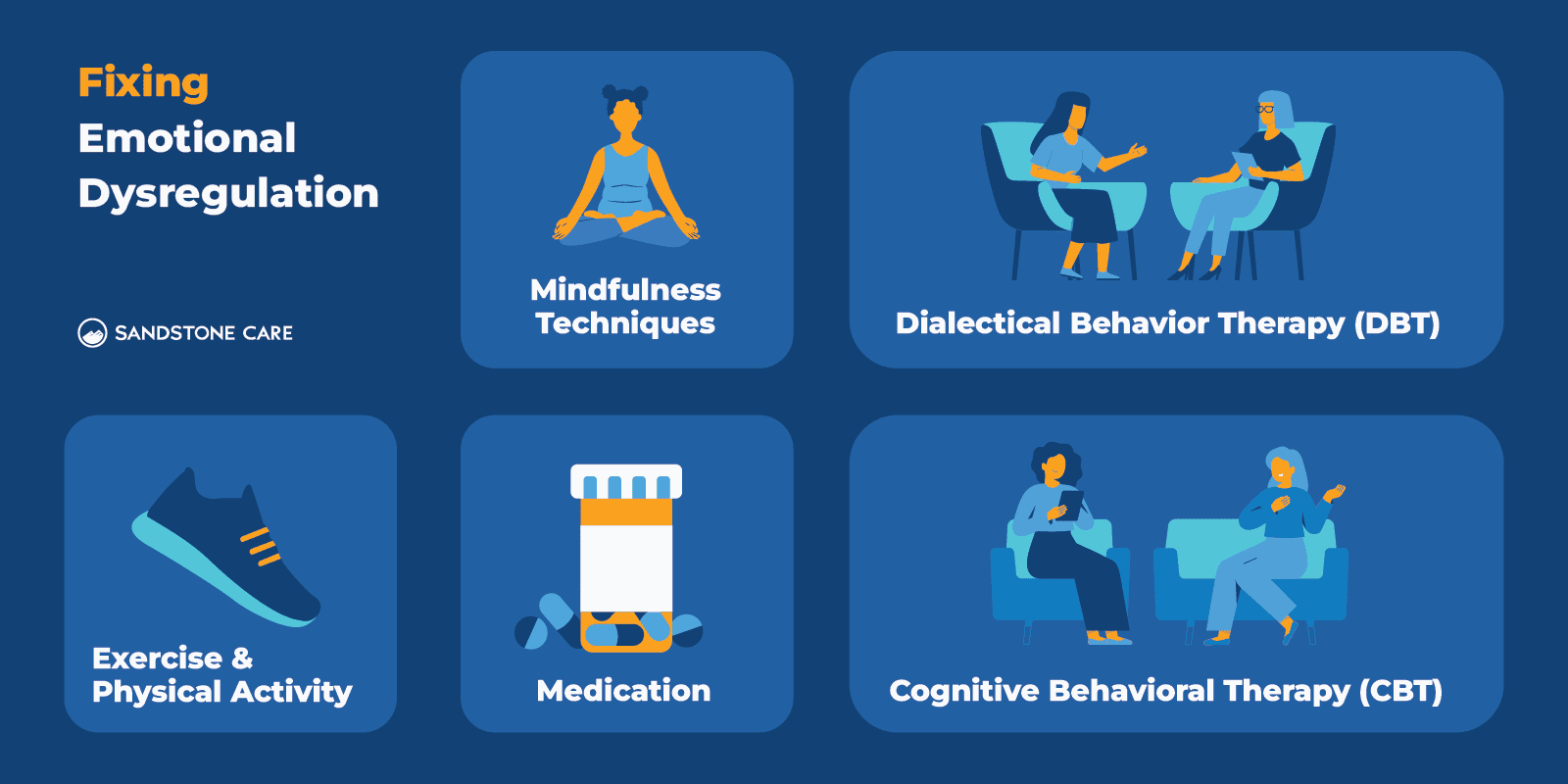
What Medication Is Best for Emotional Dysregulation?
The medication used to help treat emotional dysregulation depends on what is causing it in the individual.
For example, for individuals with ADHD, psychostimulant treatment is considered to be the first line of treatment for emotional dysregulation in ADHD, according to the American Journal of Psychiatry.
It is important to consult with a healthcare provider, psychiatrist, or other mental health professional to help you determine the best treatment options and discuss the safety and efficacy of medication in treating emotional dysregulation.
Can Adderall Help With Emotional Regulation?
Adderall is a mix of two stimulants commonly used to treat individuals with ADHD.
According to Current Psychiatry Reports, stimulants like Adderall can help enhance executive control and improve a person’s ability to suppress emotional responses.
How Do You Calm Emotional Dysregulation?
Some ways to calm emotional dysregulation on your own can include:
- Breathing Exercises
- Self-Care Techniques
- Establishing a Routine
- Mindfulness Practices
FAQ
You Have Questions, We Have Answers.
Our goal is to provide the most helpful information. Please reach out to us if you have any additional questions. We are here to help in any way we can.
Emotional dysregulation can be a component of ADHD, but the two are not the same.
ADHD is a neurodevelopmental disorder, while a number of different conditions can cause emotional dysregulation.
Emotional dysregulation is often linked to a mental health disorder but is not one on its own.
According to the Public Library of Science, evidence points to emotional dysregulation as a fourth core symptom of ADHD.
Emotional dysregulation can sometimes stem from traumatic experiences a person faces in childhood and adulthood.
A person can become stuck in a “freeze mode” when faced with an event that their brain or body perceives as threatening. Even after the event is over, feelings associated with the traumatic event can impact a person for a very long time until they get help to work through the trauma and heal.
According to Cureus, both emotional dysregulation and impulsivity are common features of borderline personality disorder (BPD) and bipolar disorder.
According to the Journal of the American Academy of Child and Adolescent Psychiatry, “Autism spectrum disorder (ASD) is associated with amplified emotional responses and poor emotional control.”
Emotional dysregulation in individuals with autism can cause difficulty using effective emotional regulation strategies and lead to impulsive reactions to stimuli.
This may cause a person to become irritated, angry, aggressive, anxious, or impulsive.


Let’s take the next steps together
We understand taking the first step is difficult. There is no shame or guilt in asking for help or more information. We are here to support you in any way we can.

